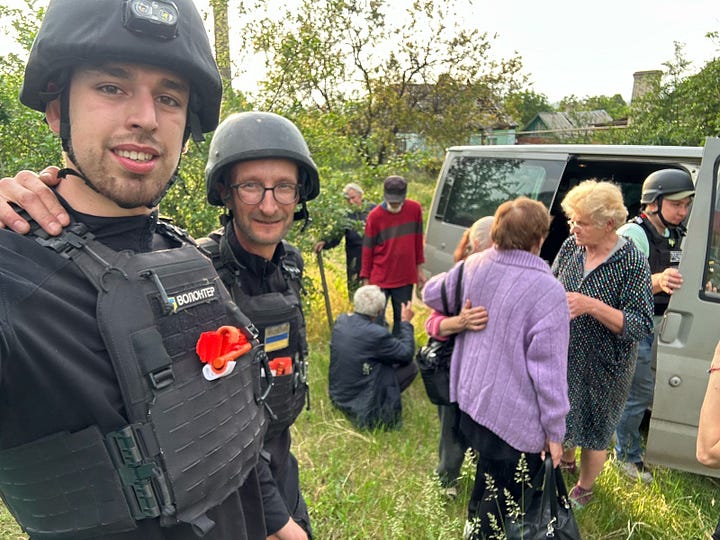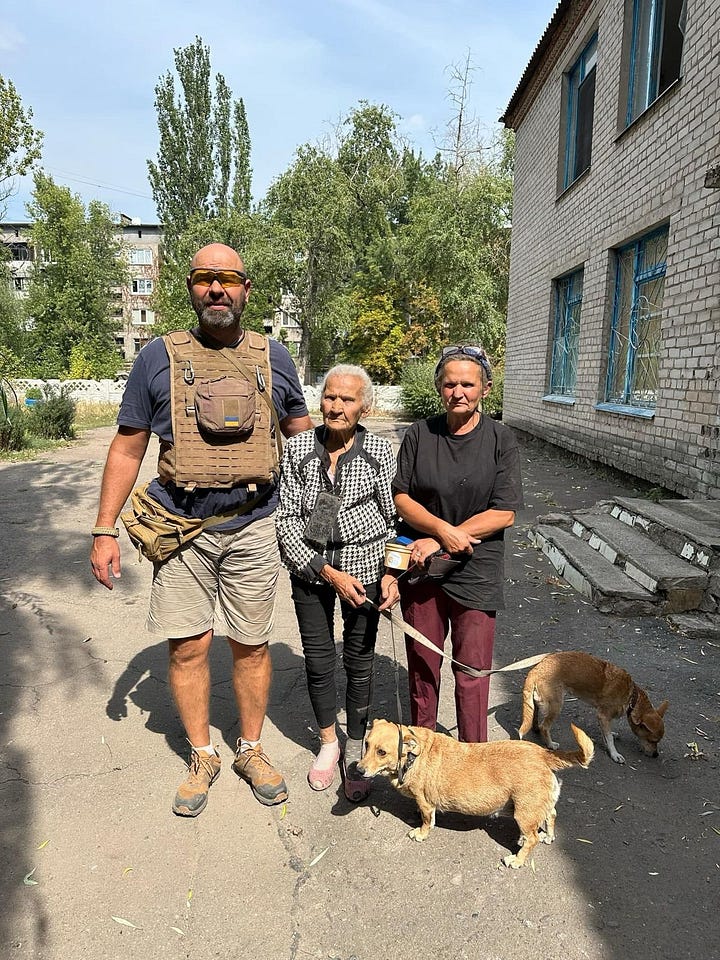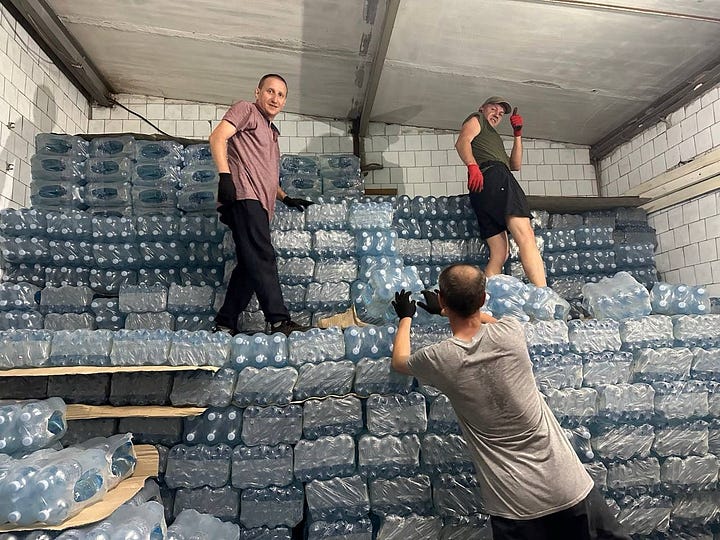The Union of Kramatorsk Volunteers
Amid stiff competition, this has to be one of the most effective Ukrainian community organisations I've met so far.
The Union of Kramatorsk Volunteers is as grassroots as you get. With about twenty-five people currently actively involved, and a Facebook page with 132 followers, they nevertheless manage to show up to provide emergency help at the sites of missile and drone strikes, run a community taxi for disabled and elderly people, unload aid lorries every few days, and, inevitably, do multiple evacuation missions to towns and villages near the frontline every week.
UKV sometimes works with Tsentr Poruch and Mar’iana put me in touch with Bohdan, their founder. We met up at an agreed location and walked down the road to conduct an interview in the comfort of his vehicle, which is…
… wonky, filthy, and slightly bashed-in by a drone strike, I can confirm this is a classic 2020s Ukrainian look. (Insert the inevitable angry comment about UN Land Rovers here. No, I have not seen any UN or Red Cross representatives in the fortnight I have spent in Kramatorsk this time so far.)
Bohdan: Here’s my car!
Me: Ah, typical! [We laugh and sit in the car for an interview.]
So, you go to the locations of missile and drone strikes?
“We have a rapid response group, as it’s called. We hear a strike, for example the one on Ria Pizza, and from experience we can usually tell where it was, whether in the town or outside it. We drive to the site and do whatever’s necessary, such as help people or clear rubble. Fortunately that doesn’t happen very often because there aren’t many events on the scale of Ria Pizza, or the hit on Marata Street. Usually strikes are on places like factories, where there’s no civilian population.
But we’ve helped in a lot of places where we had to save people and provide first aid. Apply tourniquets, bandages, talk with people. Even when we arrive at a site where no one’s been physically hurt we always have to help people calm down, talk with them about what to do next. We encounter this a lot but it’s different every time. At a minimum, people need to talk about what to do next. We talk with them, advise them to calm down and get dressed, go outside and breathe, call this number and someone will come tomorrow and help you to close up the building; we’ll come tomorrow and help you cover the windows so you can live there. It’s often about talking to them.”
Do you only go to locations within Kramatorsk?
“That depends on where we are. If we’re doing an evacuation, for example in Avdiivka… If we know there’s people at the site of a strike we head straight there. We go if we can get there quickly, within ten minutes. Rapid response. If we’re in Kramatorsk and there’s a strike in Sloviansk there’s no point going because it’ll take 40 minutes and by the time we get there other people will already be helping.”
Are there a lot of volunteer groups like yours?
“Probably not. I see police, rescuers, soldiers coming. Sometimes in the centre of the city other volunteers come. It all depends on the situation. If volunteers can get there quickly, they come, but there’s no point turning up two or three hours after a strike. Help will already have arrived.”
Do you work with the police?
“No. But they know about us. They see we’re always at impact sites, helping. If our help is needed the police understand that. If help is no longer needed they might just say, we don’t need your help today, you should go.”

Do you have any training?
“None. We’ve done some courses about how to deal with people but we’re not psychiatrists or doctors. We just know how to do first aid. If someone is badly hurt we look after them until doctors come. That we can do.””
How many times have you gone out to do this?
“I haven’t counted. Twenty, or maybe more. I don’t really know how to calculate it, because there’s physical help of the kind needed when injured people were under the rubble of Ria Pizza and we had to sort out first aid for them. And then there’s times when we come to the place and talk with people about what they’re going to do next, and that’s it. Nobody’s hurt, there’s no need for tourniquets. If you include those cases, well, try to count how many times incoming has hit the city, hit people, and that’s how many times. We are there at every strike.”




How did you start the group?
“It all started on February 25, 2022, as soon as the war began. Back then, our main job was to help other organisations, the city, to unload humanitarian aid. A lot of aid came to Kramatorsk, we had big trucks, 20 tonnes, and no one to unload them. At the moment there’s twenty-five of us, but at that point we had 110 people. There were trucks and train wagons arriving, ten wagons a day. We had to unload four hundred tonnes of humanitarian aid a day. We were ordinary volunteers, building checkpoints, distributing humanitarian aid, evacuating people, and for the first six months of the war there was physical labour every day, unloading trucks.”
What else do you do apart from emergency response at strike locations?
“The lads and I go everywhere – we help cover [holes in] roofs and windows. We also have an ambulance car that can transport people lying down. The girl manning our hotline takes a call, and off we go. There’s a lot of demand for this in Kramatorsk, because there are a lot of pensioners in the town. A lot of IDPs from Bakhmut, Avdiivka have moved here. Their health has deteriorated and when they get ill they need transportation to the hospital.”
How many cars do you have?
“I’ve only got this one. Our organisation has been given one other car. People evacuated from Chasiv Yar, went to Germany and bought a car there. Everything worked out for them, so they bought a new car and gave us the old one.
And we have our taxi. That car belongs to the organisation too. The organisation is mine, but I can’t say these are my cars. They’re… cars of the people. [Laughs]. They’re the cars of the volunteers who drive them, helping people.
So if you count those, there’s three cars constantly driving around every day, constantly working. This car is mine. It sees the most use, because it’s the best kitted out. It’s an ordinary car, I use it for my own business. But we’ve taken out the seat we have a flat area so it’s possible to transport disabled people lying down. I always use it for evacuations.”




How often do you do evacuations?
“Sometimes it’s every day, sometimes a few times a week. We do about a hundred evacuation trips a year. The largest number of people we had at one time was thirteen. My car can physically accommodate seven people, without any baggage. In general, evacuations are one or two, or at most three, people. At the moment we’re doing evacuations every day.”
Where from?
“Places beyond Kostiantynivka – Ivanopilya, Novodmitrivka, which is a village between Kostiantynivka and Chasiv Yar. At the moment the most active area for me is Kostiantynivka, the villages around there. Pokrovsk, not so much. At the moment a lot of evacuations are happening from Pokrovsk, Pokrovsk gets a lot of media coverage. It has a big media presence and a lot of volunteers go there… Yes, they help people but they go there because it’s well-known and it’ll give them a bit of a boost in every sense… It’ll earn them a name. I approach things a little differently. If I see that my help isn’t needed somewhere, there are enough volunteers there, I rescue people where nobody else is going to do it if I don’t. For various reasons, no one was going to Chasiv Yar, but we went there. Because there are people there, and they need help, and it doesn’t matter to us that nobody knows that town. There are also other volunteers who work this way, go to villages where there is a lot of need for help, for evacuations, but nobody has heard of them. And there are volunteers who go because of hype.
So now I try to do fewer evacuations from Pokrovsk on the whole, depending on what’s possible, because I know there are people in Pokrovsk who can do this job so I’d better pass it on to them. And they go and get the people from Pokrovsk. If necessary, we’ll go there, sure. At the moment, we mostly go to villages near Kostiantynivka.”
How many people are evacuating from Kramatorsk itself now?
“Not many at all. It’s relatively safe in Kramatorsk. The frontline isn’t far away, but compared to the places people have left, or are still living, we don’t get much incoming here. The front line moves very slowly.
Over three years, we’ve gradually got used to this war. People are used to it, they don’t want to evacuate because they understand how that will go.”
If the situation gets worse, will you help pensioners evacuate Kramatorsk?
“We will help absolutely everyone. Whoever needs evacuation, we will evacuate.”


How much does it cost to run UKV?
Our main costs are fuel and vehicle maintenance. We have four cars, and fuel is about 30,000 hryvnia (£554/US$725), and vehicle maintenance about 20,000 hryvnia (£369/US$483) a month.
Sometimes we have to replace tools broken while resconstructing houses. It’s about 2-3,000 hryvnias (£37-£55/US$48-$72) a month for tools and maintenance.
Who funds the work?
Until February we had a donor. Recently we had a fundraiser for fuel and raised 9,000 hryvnia (£171/US$217). Now I’m mostly spending my own savings.
Whaaaaaaat? I sent Bohdan £288, which is the money raised from the new or renewed paid subscriptions to this blog in the month prior to the interview - thank you to Sean S, Nicola R, Silvia G, Alan K, David P, Jemma1 and H. D. Can anyone boost that by £100 to provide UKV with a month’s fuel?
PayPal: bogdanzuyakov@gmail.com






"Effective" is an understatement! Fantastic hands-on help!
I read about the tools and their occasional replacement, but I wonder where they source, how they pay for and where they keep the rebuilding materials: OSB, corrugated sheets and other bulky stuff...
Once again Anna, you bring us grass-roots inspiration that is far more efficient and meaningful than the bloated, big aid names. Thank you so much 🙏